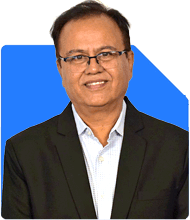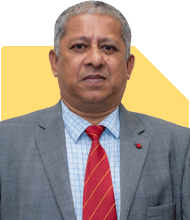I'm 38 with Rs. 50 Lakh corpus, How to grow it for a 30+ year Rs. 40K monthly income?
Ramalingam Kalirajan |10017 Answers |Ask -Follow
Mutual Funds, Financial Planning Expert - Answered on Oct 16, 2024
He has an MBA in finance from the University of Madras and is a certified financial planner.
He is the director and chief financial planner at Holistic Investment, a Chennai-based firm that offers financial planning and wealth management advice.... more

I am 38 with a monthly sip of 12000 which I increase annually by 5%. I have an accumulated corpus of around 50 lakhs. How to grow this money so I can generate a second income of around 40k which can last for minimum 30+ years and how long do I need to stay invested?
Assessing Your Current Investments
Understanding your existing investments is the first step towards building a robust financial plan. You currently have a monthly SIP of Rs 12,000 and a considerable corpus. Here’s how to leverage your current assets to optimize growth:
Increase SIP Gradually: Your current strategy includes a 5% annual increase in your SIP. While this is a solid plan, you might want to consider a more aggressive approach. If your income allows, increasing your SIP by 10% annually could significantly impact your total corpus by the time you plan to start withdrawing funds. This acceleration can be especially beneficial given the power of compounding.
Diversify Your Investments: Diversification is key to reducing risk while maintaining growth potential. If your SIPs are heavily weighted in equities, consider incorporating a mix of hybrid and balanced mutual funds into your portfolio. This strategy helps protect your investments during market downturns while still allowing for capital appreciation. A balanced approach can stabilize your returns over time.
Active Fund Management: Investing in actively managed mutual funds can provide an edge in terms of returns. While index funds can track the market, they lack the ability to outperform it. By investing in actively managed funds, you benefit from professional management that adjusts holdings based on market conditions and sector performances. This flexibility can lead to better long-term growth, essential for generating the desired income.
Disadvantages of Index Funds and ETFs
While considering various investment options, you may encounter index funds or exchange-traded funds (ETFs). Here are some critical points to consider regarding their limitations:
Limited Growth Potential: Index funds aim to replicate market returns. While they provide some level of security, they do not offer the potential for higher returns. In contrast, actively managed funds aim to outperform the market. Given your goal of generating Rs 40,000 per month, it’s vital to choose investments with a greater potential for capital appreciation.
Market Volatility Exposure: Index funds are exposed to market volatility without any cushioning. In a downturn, these funds will likely experience losses without the flexibility of a fund manager to make strategic adjustments. In contrast, actively managed funds have the potential to mitigate losses by reallocating assets during turbulent times.
Lower Flexibility: Index funds have rigid investment strategies. Once the index is set, it cannot be adjusted. This can be detrimental during periods of economic downturn. Actively managed funds, on the other hand, allow fund managers to shift investments to sectors or stocks that show promise, improving potential returns and providing a cushion during market corrections.
For your long-term goal of generating income, actively managed funds will be a more appropriate choice.
Importance of Regular Funds over Direct Funds
Direct mutual funds might seem attractive due to their lower expense ratios, but here’s why regular funds through a Certified Financial Planner (CFP) can offer more significant benefits:
Professional Guidance: Regular funds include the service of a financial advisor who can help tailor your investment strategy to your specific needs and goals. This personalized advice can be invaluable in navigating complex financial markets and ensuring your portfolio aligns with your long-term objectives.
Rebalancing and Monitoring: Regular funds provide ongoing monitoring and rebalancing of your portfolio. A CFP can help you adjust your asset allocation based on market conditions and changes in your financial situation. This active management can significantly enhance your portfolio’s performance and risk-adjusted returns.
Emotional Support During Volatility: Market fluctuations can induce panic, leading to impulsive financial decisions. A CFP can provide reassurance and clarity during these times, helping you stay focused on your long-term goals rather than reacting to short-term market movements.
Optimizing Your Portfolio for Income
To achieve your target of Rs 40,000 per month for 30+ years, your portfolio needs to be structured for both growth and withdrawal.
Systematic Withdrawal Plan (SWP): Once you reach your desired corpus, consider implementing a systematic withdrawal plan (SWP). An SWP allows you to withdraw a fixed amount every month from your mutual funds. This approach can provide you with a steady second income, ensuring financial stability.
Strategic Asset Allocation: As you approach the time when you want to start generating income, it’s wise to shift some of your portfolio from high-risk equities to balanced or hybrid funds. This strategy reduces volatility while still allowing for growth potential. Maintaining a diversified portfolio ensures that you can weather market fluctuations without jeopardizing your income stream.
Tax Efficiency Considerations: Understanding capital gains taxation is crucial when planning your withdrawals. For equity mutual funds, long-term capital gains (LTCG) exceeding Rs 1.25 lakh are taxed at 12.5%, while short-term capital gains (STCG) are taxed at 20%. For debt funds, both LTCG and STCG are taxed according to your income tax slab. A well-structured withdrawal strategy can help you manage tax implications effectively, allowing more of your income to remain in your hands.
Setting a Time Horizon for Your Investment
Establishing a clear time horizon for your investment is vital for achieving your income goal.
Minimum Investment Duration: To generate the desired income, aim to stay invested for at least another 10-12 years. This duration allows your investments to grow through compounding, increasing your chances of reaching the level where Rs 40,000 per month becomes a sustainable income.
Avoiding Early Withdrawals: The earlier you begin withdrawing funds, the harder it will be to maintain your corpus for the long term. Focus on allowing your investments to grow for as long as possible before starting to withdraw your monthly income. This approach ensures that your portfolio can withstand market fluctuations and continue to provide income in the future.
Balancing Growth and Risk
Maintaining a balance between growth and risk is essential to sustain your income over the long term.
Avoid Complete Shift to Low-Risk Assets: While it may be tempting to move all your investments to safer assets, such as debt funds, doing so limits your growth potential. It’s crucial to retain a portion of your investments in equities or hybrid funds, which can continue to provide growth even as you start withdrawing income.
Regular Portfolio Reviews: Schedule annual reviews of your portfolio with a CFP to ensure your investments remain aligned with your income goal. This ongoing assessment helps you make necessary adjustments, reducing risks and maximizing returns.
Generating a Sustainable Income
Ensuring that you can consistently generate Rs 40,000 per month requires a well-structured withdrawal strategy and ongoing investment management.
Implementing SWP: Utilize an SWP to withdraw a fixed amount every month from your mutual fund investments. This method provides a predictable income stream while allowing your remaining investments to continue growing.
Reinvesting Excess Gains: If your investments perform well and exceed your monthly withdrawal needs, consider reinvesting the excess gains. This practice helps ensure that your corpus continues to grow, allowing you to sustain your income for longer.
Establishing an Emergency Fund: Keep a separate emergency fund to cover unexpected expenses. By having a safety net, you can avoid dipping into your investment corpus, which helps maintain your income stream and prevents unnecessary depletion of your savings.
The Importance of Retirement Planning
Planning for retirement is essential for long-term financial stability. It helps you prepare for the lifestyle you desire while ensuring that you have sufficient funds to meet your needs. Here are some key points to consider:
Understanding Retirement Needs: Start by identifying your expected monthly expenses during retirement. Consider all aspects of your lifestyle, including travel, healthcare, and leisure activities.
Adjusting for Inflation: Keep in mind that inflation will impact your purchasing power over time. Your investment strategy should account for inflation to ensure that your income maintains its value throughout your retirement.
Setting Realistic Goals: Be realistic about your goals and the lifestyle you want to achieve in retirement. While it’s essential to aim high, setting achievable targets can help keep you motivated and focused on your financial plan.
Final Insights
You have already built a solid financial foundation with Rs 50 lakhs and a structured SIP of Rs 12,000. To achieve your goal of generating Rs 40,000 per month for over 30 years, it’s crucial to increase your SIP, optimize your portfolio, and manage your withdrawals effectively. By staying invested for at least 10-12 more years and maintaining a balanced approach to risk and growth, you can enjoy a stable second income while ensuring financial security for the long term.
Investing in actively managed funds and working with a Certified Financial Planner (CFP) will further enhance your chances of success. Remember to review your portfolio regularly and make necessary adjustments to align with your goals. By implementing these strategies, you will be well on your way to achieving your financial aspirations.
Best Regards,
K. Ramalingam, MBA, CFP,
Chief Financial Planner,
www.holisticinvestment.in
https://www.youtube.com/@HolisticInvestment
You may like to see similar questions and answers below
Ramalingam Kalirajan |10017 Answers |Ask -Follow
Mutual Funds, Financial Planning Expert - Answered on Apr 23, 2024
Sunil Lala |222 Answers |Ask -Follow
Financial Planner - Answered on Feb 11, 2024
Ramalingam Kalirajan |10017 Answers |Ask -Follow
Mutual Funds, Financial Planning Expert - Answered on May 26, 2024
Ramalingam Kalirajan |10017 Answers |Ask -Follow
Mutual Funds, Financial Planning Expert - Answered on May 06, 2024
Ramalingam Kalirajan |10017 Answers |Ask -Follow
Mutual Funds, Financial Planning Expert - Answered on Jan 24, 2025
Prof Suvasish Mukhopadhyay |2742 Answers |Ask -Follow
Career Counsellor - Answered on Jul 31, 2025
Prof Suvasish Mukhopadhyay |2742 Answers |Ask -Follow
Career Counsellor - Answered on Jul 31, 2025
Dr Nagarajan J S K |2116 Answers |Ask -Follow
NEET, Medical, Pharmacy Careers - Answered on Jul 31, 2025
Dr Nagarajan J S K |2116 Answers |Ask -Follow
NEET, Medical, Pharmacy Careers - Answered on Jul 31, 2025
Dr Nagarajan J S K |2116 Answers |Ask -Follow
NEET, Medical, Pharmacy Careers - Answered on Jul 31, 2025
Dr Nagarajan J S K |2116 Answers |Ask -Follow
NEET, Medical, Pharmacy Careers - Answered on Jul 31, 2025
Dr Nagarajan J S K |2116 Answers |Ask -Follow
NEET, Medical, Pharmacy Careers - Answered on Jul 31, 2025
Nayagam P P |9752 Answers |Ask -Follow
Career Counsellor - Answered on Jul 31, 2025
Nayagam P P |9752 Answers |Ask -Follow
Career Counsellor - Answered on Jul 31, 2025
Ravi Mittal |629 Answers |Ask -Follow
Dating, Relationships Expert - Answered on Jul 31, 2025











.jpg)











